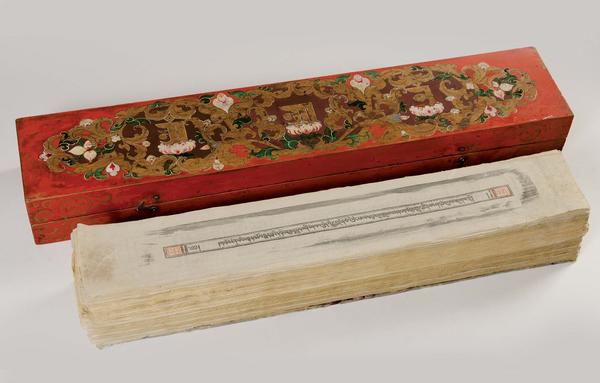Rgyud-Bzhi (‘The Four Tantras’) is the basic text of the Tibetan Medicine where the centuries-long experience of the Tibetan healers is collected. It dates back to the 12th century. The basis of ‘The Four Tantras’ are two medical tractates: ‘Charaka Samhita’ (India) and ‘The Moon King’ (China). Rgyud-Bzhi’s creation is connected with the name of a well-known Tibetan doctor the Younger Yuthog Tontan Gonpo (1112-1203), who arranged the whole tractate made of 156 chapters after rethinking and revision of the ancient sources.
Rgyud-Bzhi is told by Buddha Shakyamuni, or more correctly his medical hypostasis Bhaisajyaguru, who immerses himself in the process of contemplation and emanates five rishis for this purpose. Rishi is the Buddha’s personification, who represents his personality in such aspects as language, soul, body, deeds and virtues. The main characters in the whole text are Bhaisajyaguru and the language personification rishi Manosiji.
Rgyud-Bzhi consists of four volumes, or tantras. The Buddha doesn’t take part in the process of narration, before each tantra he immerses himself in meditation and disengages from it when the tantra is finished. The rest four rishis, which come out of the different Buddha’s body parts and tell each one tantra, answer the Manosiji’s questions one after another.
“The Root Tantra” consists of 6 chapters. It contains a brief religious version of the medicine origin and the summary of all four volumes along with the description of so called “The Medicine Tree”
“The Exegetical Tantra” consists of 31 chapters. It is a theoretical part of the Tibetan medicine based on the borrowings from the Indian sources. It states the study of three physiological origins namely pneuma, bile, and phlegm along with the review of the medicaments of floral, mineral and animal origin, and the description of surgical instruments, the curing methods, healer’s qualification demands, and medical ethic.
‘The Instructional Tantra’ is composed of 92 chapters. It is the biggest volume which is dedicated to the specific issues of the applied medicine where all known at the time diseases were described according to the unified scheme.
‘The Subsequent Tantra’ consists of 27 chapters and states the diagnostics methods based on pulse and urine, establishing diagnosis, revealing the maleficent spirits resulting in the illnesses, and rituals for their deactivation. Furthermore, it contains recommendations for gathering and preparing the dosage formulations, methods of the body purification, applying and the very technique of carrying off the external procedures such as baths, compresses, enemas, caloripuncture, bloodletting, oil inunctions.
In the end of the tractate the instructions about the continuous transmission of the healing art, the disciple’s education and selection are cited.
Rgyud-Bzhi is told by Buddha Shakyamuni, or more correctly his medical hypostasis Bhaisajyaguru, who immerses himself in the process of contemplation and emanates five rishis for this purpose. Rishi is the Buddha’s personification, who represents his personality in such aspects as language, soul, body, deeds and virtues. The main characters in the whole text are Bhaisajyaguru and the language personification rishi Manosiji.
Rgyud-Bzhi consists of four volumes, or tantras. The Buddha doesn’t take part in the process of narration, before each tantra he immerses himself in meditation and disengages from it when the tantra is finished. The rest four rishis, which come out of the different Buddha’s body parts and tell each one tantra, answer the Manosiji’s questions one after another.
“The Root Tantra” consists of 6 chapters. It contains a brief religious version of the medicine origin and the summary of all four volumes along with the description of so called “The Medicine Tree”
“The Exegetical Tantra” consists of 31 chapters. It is a theoretical part of the Tibetan medicine based on the borrowings from the Indian sources. It states the study of three physiological origins namely pneuma, bile, and phlegm along with the review of the medicaments of floral, mineral and animal origin, and the description of surgical instruments, the curing methods, healer’s qualification demands, and medical ethic.
‘The Instructional Tantra’ is composed of 92 chapters. It is the biggest volume which is dedicated to the specific issues of the applied medicine where all known at the time diseases were described according to the unified scheme.
‘The Subsequent Tantra’ consists of 27 chapters and states the diagnostics methods based on pulse and urine, establishing diagnosis, revealing the maleficent spirits resulting in the illnesses, and rituals for their deactivation. Furthermore, it contains recommendations for gathering and preparing the dosage formulations, methods of the body purification, applying and the very technique of carrying off the external procedures such as baths, compresses, enemas, caloripuncture, bloodletting, oil inunctions.
In the end of the tractate the instructions about the continuous transmission of the healing art, the disciple’s education and selection are cited.



